|
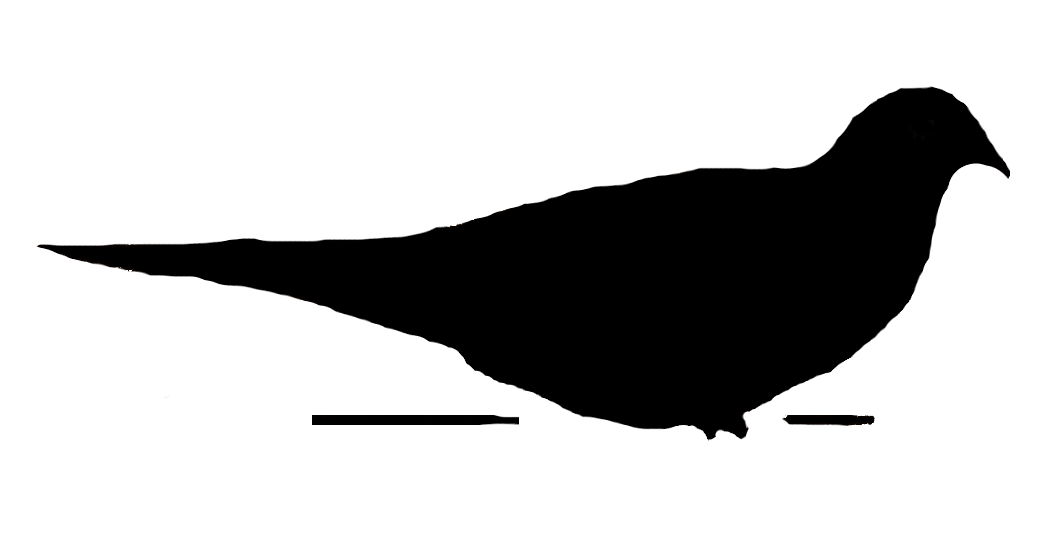 CAGE CAGE 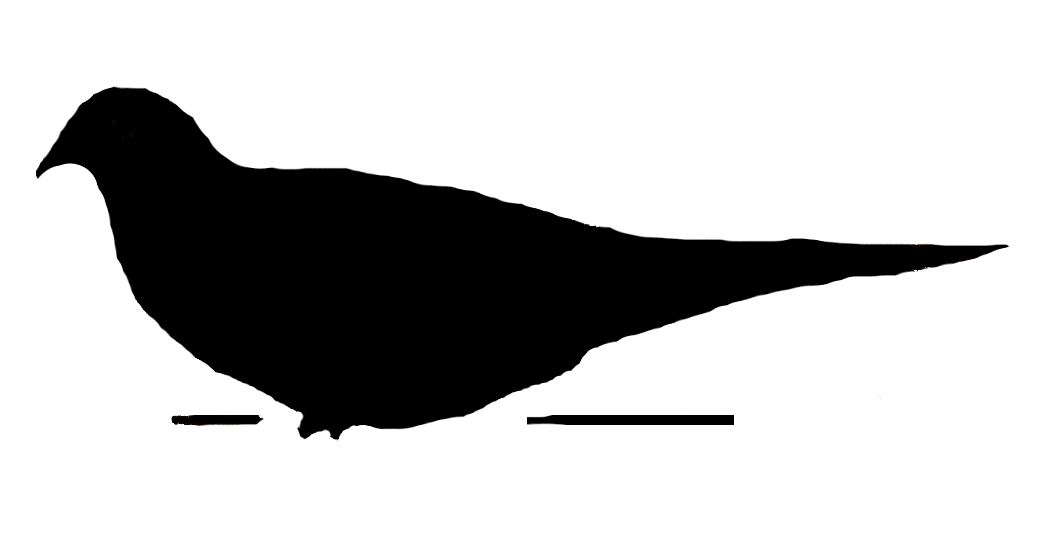
PLEASE NOTE WITH PARTICULAR ATTENTION AND CARE
Mourning Doves are "wild", and are NOT bought/sold legally. They're NOT "PETS" and must not be seen as such. They CAN adjust and become acclimated to being in the house, and in a *PROPER* cage. In fact, in the house, a cage should NEVER be a place of confinement or "prison". It SHOULD be a "refuge", a place of safety, a "little house" that provides a dove with safety, security, a place in which to eat and digest, rest, relax, exercise, be comfortable and feel safe, cared for and about... loved and respected. There are basic essentials, necessities and requirements that, in some respects, differ from a "pet bird" and these cannot be ignored. Providing an environment that mimics, as closely as is possible, a dove's natural environment isn't merely to your convenience, it is a non-negitiable responsibility. If, for any reason, you cannot provide the requirements, you cannot properly care for a mourning dove and must seek a proper place for him/her, other-wise, you will cause irreparable damage.
This page covers:
Bathing/Bath • Cleaning/Maintenance • Covering a cage • Flooring/Substrate • Lighting • Perches • Placement of Cage • Plants • Sand/Gravel • Size • Water
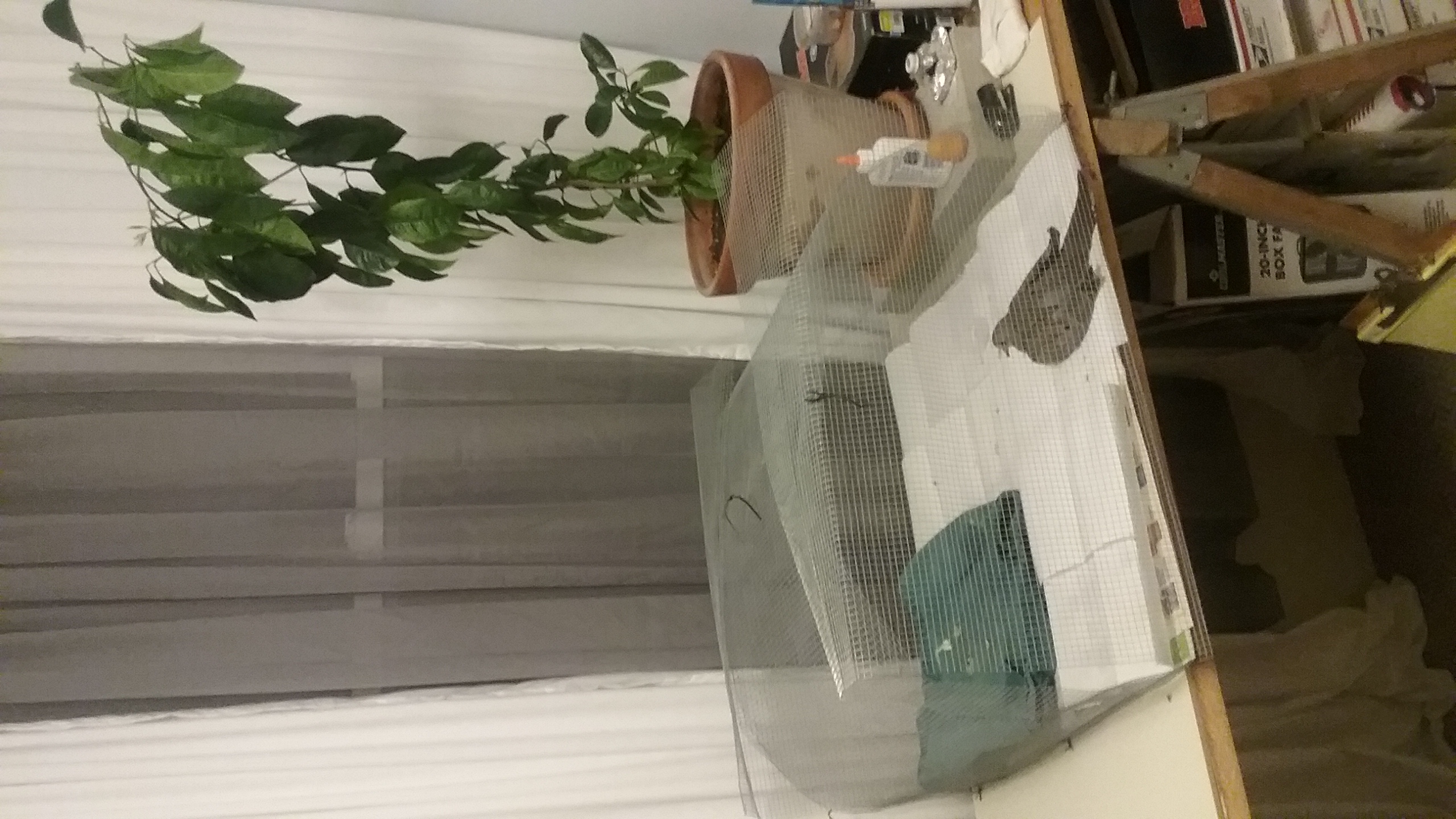
|
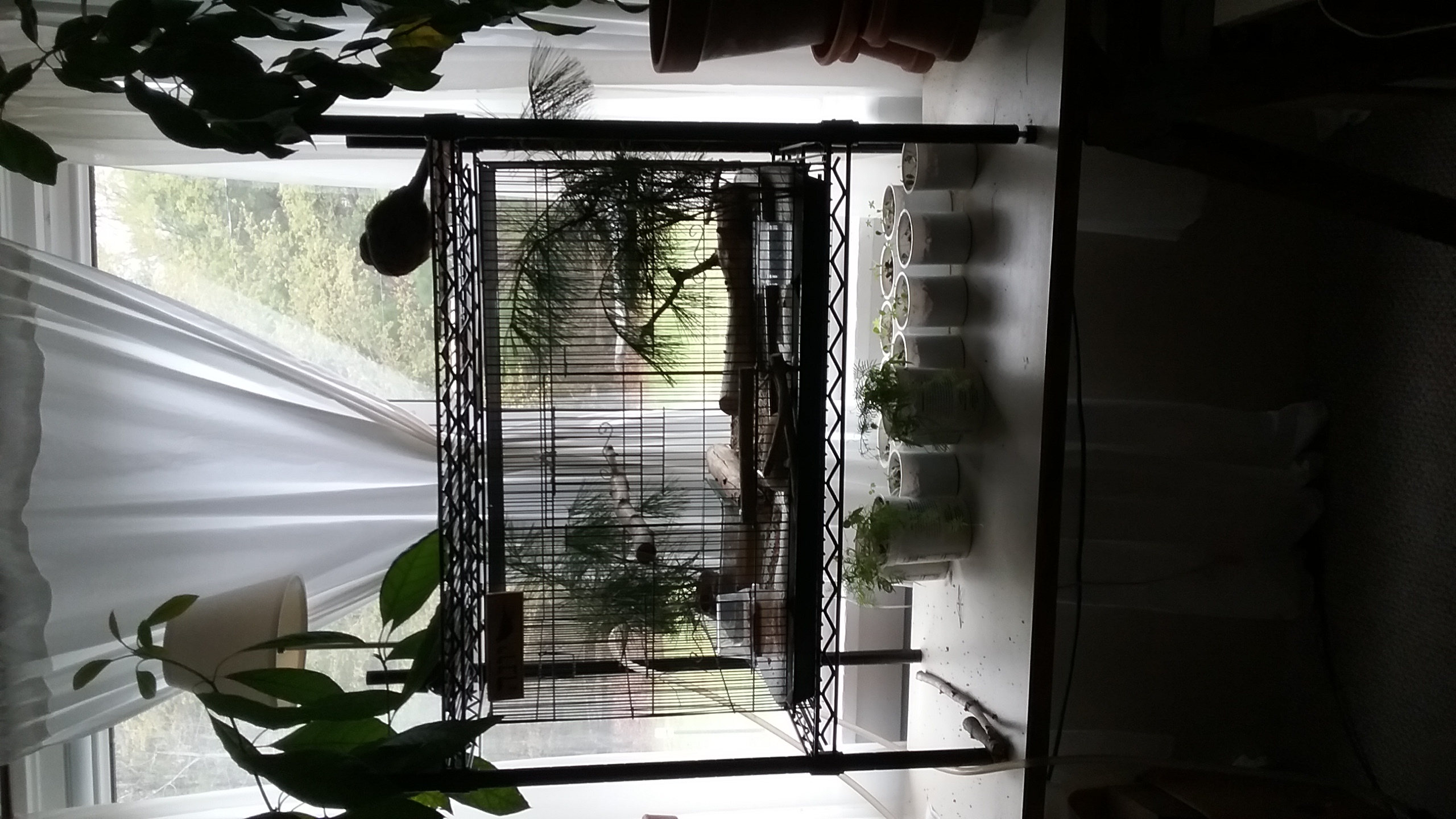
|
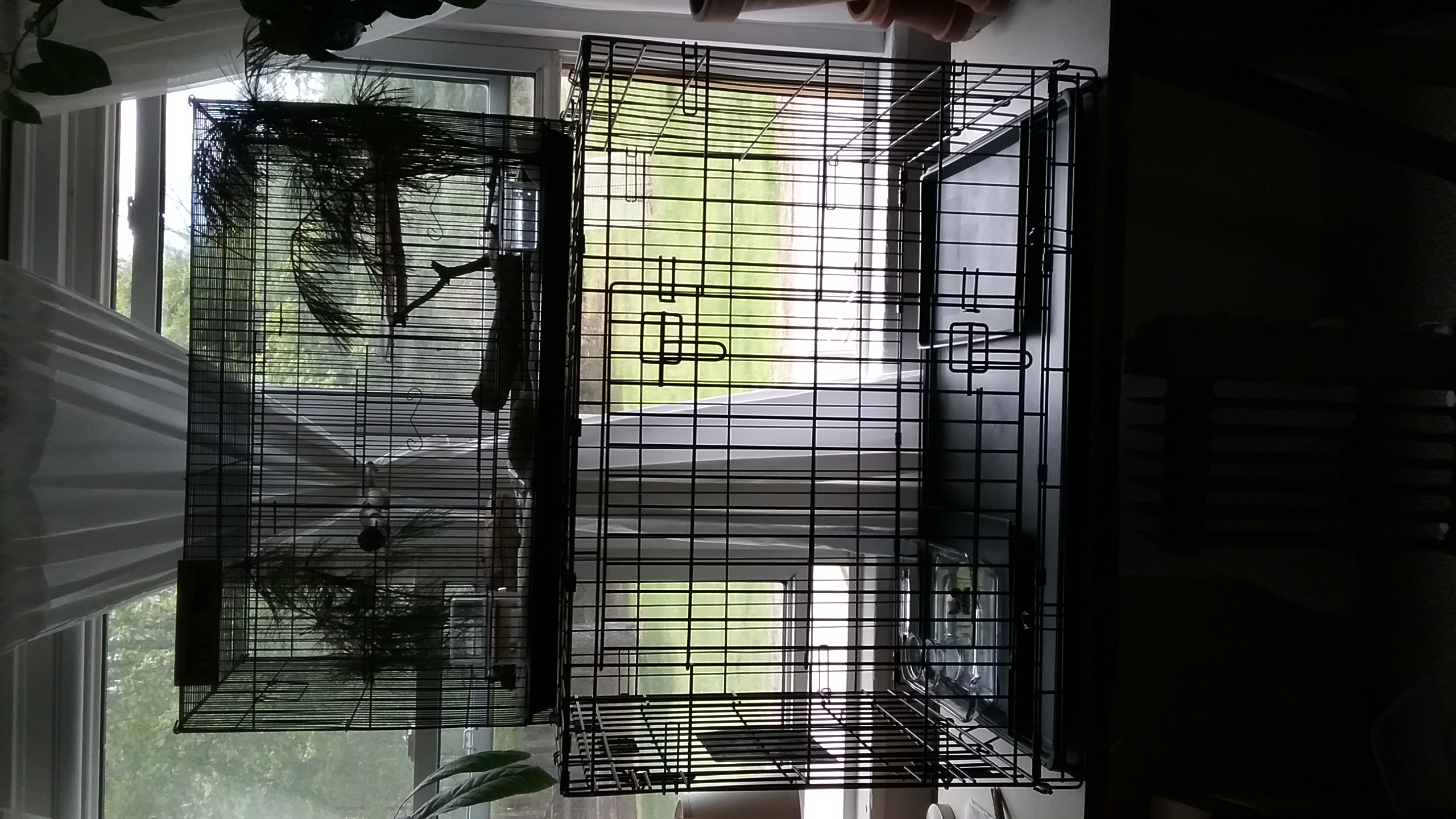
|
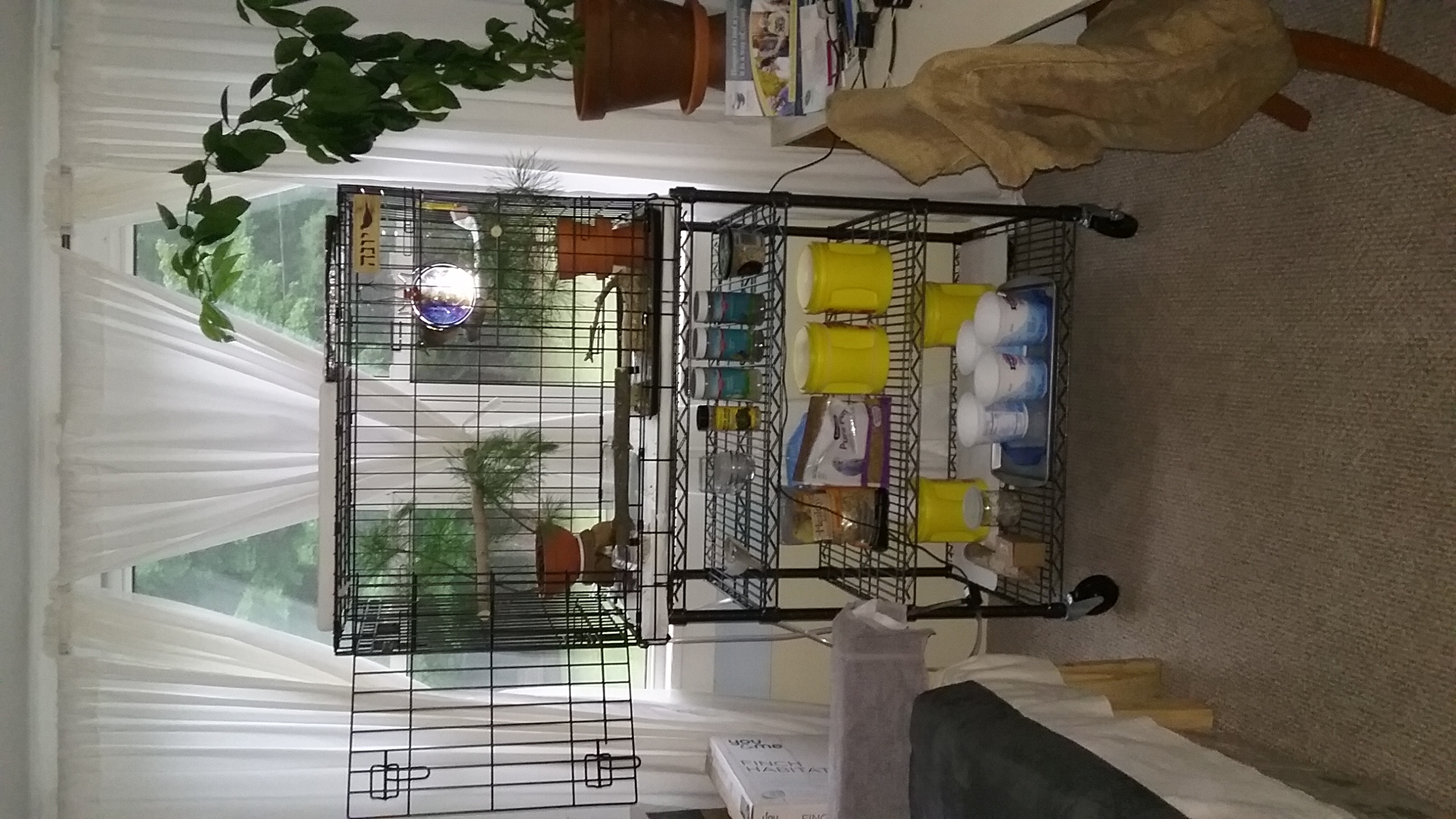
|
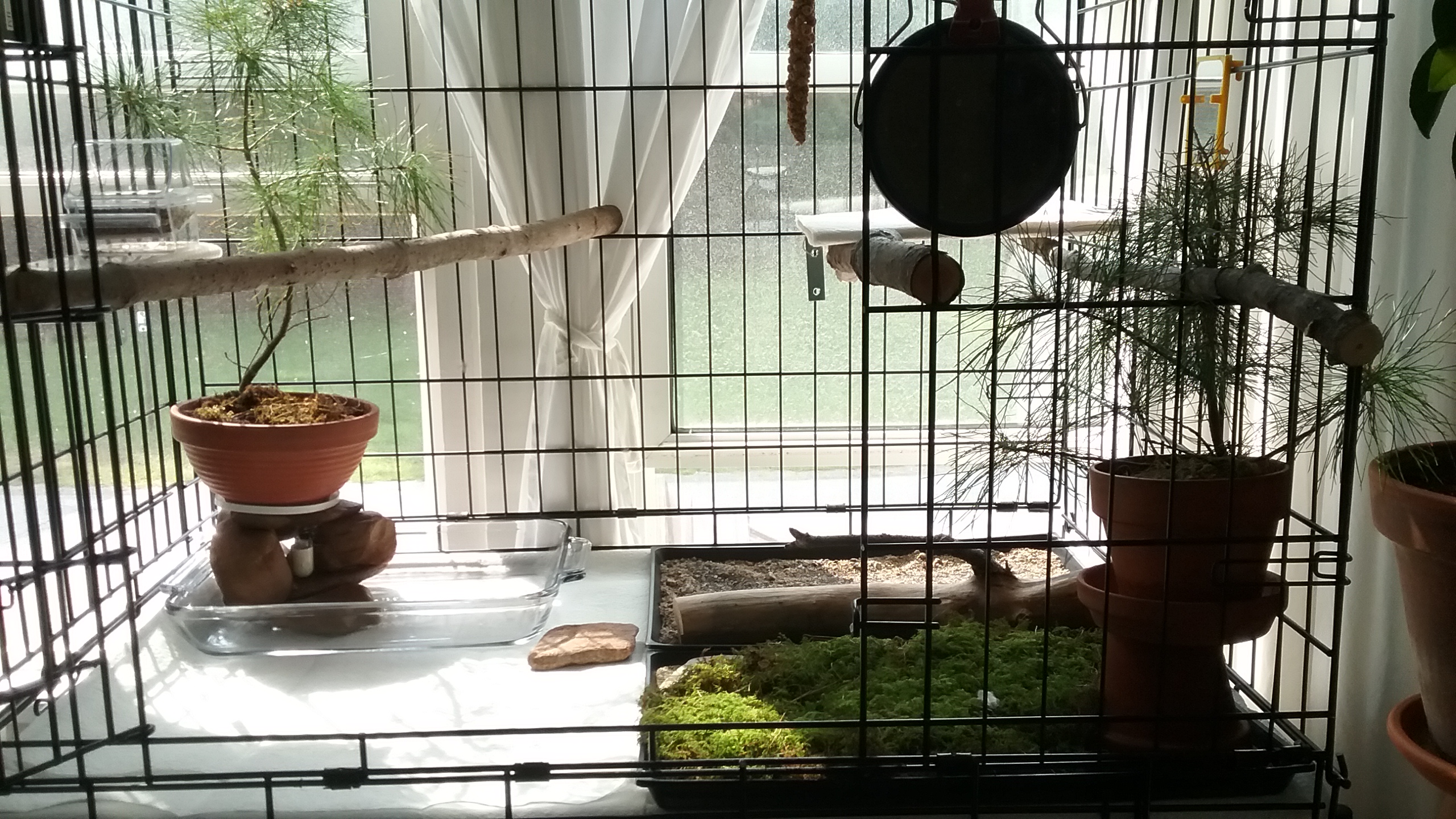
"Life Stages Midwest" Large
|
 CAGE REQUIREMENTS CAGE REQUIREMENTS
It's recommended that doves have a minimum of 10 square feet/3 square metres for each pair.
For a single young or adult dove, the absolute minimum size recommendation is 30in/76cm long, 18in45,7cm deep, 18in/45,7cm high. Cages of this size are readily available at most pet stores and on-line.
"Dog cages/crtes" can be used for adult doves. They have a removable tray at the bottom which can be easily cleaned and do not have "wire flooring" which is important as you do NOT want to have wire flooring. It isn't easier to keep clean and it can cause horrific discomfort and injury to a dove's feet.
36in/91cm long, 24in/61cm deep, 27in/69cm high is comfortable and provides perfect space for a single dove to "stretch" his/her wings and travel about. *Note the spacing/"mesh" on a dog cage. Most suitable is 1,5in/4cm. A dove usually will not try to fit through this, and an adult won't fit through. This is usually considered a "Large" cage and is also readily available and not costly, at most proper pet stores as well as on-line. Also, the door on a dog cage is larger so it gives more access for cleaning and for the dove to come and go, if flying about the house is OK.
You can also make your own cage, if so inclined. Avoid "construction mesh",which resembles screening, (also called "metal sheeting"), usually silver, with small square openings. This is fine for temporary housing (as you'll see, I used this, early on when Yonah came into the house) but it's "confining" and not "airy". Remember, mourning doves are wild, and they're accustomed to open spaces. The housing you provide must NOT be a "prison".
If you can afford or prefer, there are "flight" cages available which are much larger (and considerably more expensive) which give enough space for flying and exercise with-out leaving the cage.
If the bottom of the cage is wire, cover with a few layers of clean newspaper or some other appropriate material. Imagine if YOU had to constantly try walking on that wire. (A product that I have used with great success is "Duck" brand "Easy Liner", clear plastic, placed with the "textured" side down. It's available in 20in/50,8cm x 4ft/1,2m. I cover this with a double layer of inexpensive kitchen roll/paper towels so that Yonah doesn't slide on it. It provides a sturdy surface for him to walk comfortably on. And it's very easy to maintain. Just roll up the paper and replace.)
The natural habitat of mourning doves is open forest and farm-land, thin trees and fence-rows. They're also fond of open gravel/sand or dirt areas where they bask in the sun. Keep this in mind when creating a "home" in a cage.
Clean sand can be spread in a cookie sheet or something similar, that fits in half of the cage. It isn't recommended to buy "aquarium sand/gravel", and certainly nothing that has any colouring in it should be in there since doves will eat the smaller bits as "grit" to help in digestion of food. "All purpose" sand or "sandbox" sand is perfectly acceptable. However, it's a good idea to rinse ALL sand, thoroughly, to ensure nothing but sand is put into the cage. (If you're of a mind, rinse the sand until the run-off water is clear, then put it in a stainless steel or other oven-proof bowl and heat it in a 400F (205C) degree oven for about an hour at least. This will make sure that there are no parasites in the sand. (Remember, cleanliness is important for both you and the dove.)
 Perches made from actual tree branches/limbs are best. When cutting these, make sure the wood/tree isn't infested with any sort of "fungal growth" or insects and be sure the species of tree isn't toxic. There is a list of "Toxic" and "Non-Toxic" plants and woods on this site. Perches made from actual tree branches/limbs are best. When cutting these, make sure the wood/tree isn't infested with any sort of "fungal growth" or insects and be sure the species of tree isn't toxic. There is a list of "Toxic" and "Non-Toxic" plants and woods on this site.
 Mourning doves roost in trees and will, of a night, sleep in them. If possible, include some cuttings from local wood-land trees. (I've cut fresh white pine which I "bundle" in 3-5 sprigs, floor-to-top-of-cage length. Wrapping the bottom of the bundle in a bit of plastic wrap, taped securely, keeps sap from dripping onto the cage. A "bundle" placed in 2 corners gives an atmosphere of "out-doors", a more "natural" environment. They're replaced as they dry-out.) In a large dog cage/crate, you'll find that there is enough room to include a small, potted, live tree. Again, check for "toxicity". Yonah has young white pines in small terracotta pots in his house. They're easy to find in local wood-lands and easy to maintain.) Mourning doves roost in trees and will, of a night, sleep in them. If possible, include some cuttings from local wood-land trees. (I've cut fresh white pine which I "bundle" in 3-5 sprigs, floor-to-top-of-cage length. Wrapping the bottom of the bundle in a bit of plastic wrap, taped securely, keeps sap from dripping onto the cage. A "bundle" placed in 2 corners gives an atmosphere of "out-doors", a more "natural" environment. They're replaced as they dry-out.) In a large dog cage/crate, you'll find that there is enough room to include a small, potted, live tree. Again, check for "toxicity". Yonah has young white pines in small terracotta pots in his house. They're easy to find in local wood-lands and easy to maintain.)
In a larger cage, small plants in containers can be included BUT BE SURE THE PLANTS YOU CHOOSE ARE NOT TOXIC TO BIRDS... THEY WILL PECK AT THE LEAVES AND SOME COMMON PLANTS CAN CAUSE ILLNESS AND/OR DEATH. Again, there's a list of "Safe and Toxic" plants on the "Medical" page, and, be sure that the plant is small enough to allow space for "exercise flying" inside the cage.
 Place the cage by a sun-lit window but be sure that it's NOT in EXCECSSIVELY HOT sun nor in a drafty window (especially in Winter). Doves love to "bask" in warm sun-light, but at least half of the cage should offer shade, and the "sunny" part should preferably be in the sun or, at least, in the area with the brightest light. Place the cage by a sun-lit window but be sure that it's NOT in EXCECSSIVELY HOT sun nor in a drafty window (especially in Winter). Doves love to "bask" in warm sun-light, but at least half of the cage should offer shade, and the "sunny" part should preferably be in the sun or, at least, in the area with the brightest light.
 Bathing is IMPORTANT for doves (and all critters... as it is with "human" critters). It keeps them clean,cool, refreshed, and helps deter mites and other parasites. Although mourning doves enjoy "dirt/dust bathing", as can be seen in their natural habitats, on dirt roads or bare spots in fields and meadows, the certainly DO enjoy a leisurely soak-and-splash in a pond, pool or puddle. So including a place for the activity is as imperative as it is to provide fine sand in the cage. Bathing is IMPORTANT for doves (and all critters... as it is with "human" critters). It keeps them clean,cool, refreshed, and helps deter mites and other parasites. Although mourning doves enjoy "dirt/dust bathing", as can be seen in their natural habitats, on dirt roads or bare spots in fields and meadows, the certainly DO enjoy a leisurely soak-and-splash in a pond, pool or puddle. So including a place for the activity is as imperative as it is to provide fine sand in the cage.
|
|
If at all possible, a "dish" of some kind, large enough for the dove to stand in comfortably, not contrained, with not more than an inch (2,5cm) of CLEAN water in it can be placed in a corner of the cage for bathing. If you put one in, be sure to change the water EVERY day as birds tend to "poo" as they need. Faeces (poo) in the water will create bacteria, and birds will not only soak in it but will drink it too. (Think: bird-bath in a garden.) If you'd like, you an get a small "water feature" garden pump and some "food grade" tubing and with some imagination, make a small "fountain" to create motion in the water which will attract a dove more-so than still water. *Check the tubing daily, as you change the water. Algae and mineral deposits can grow/form on the inside of the tubing and IN THE PUMP. To avoid this, NO LESS THAN MONTHLY remove the dish, pump and tubing from the cage and, in a kitchen basin:
|
Set the system up to run to flush with a 50/50 solution of plain, "white" vinegar and water for about an hour. Then, with tap running into the dish, flush with plain water for 15 minutes, at least. This will clean the tubing AND the inner parts of the pump.
Rule of thumb for water: IF YOU WOULDN'T DRINK IT, IT DOESN'T BELONG IN THE CAGE... EVER. Easy-peasy.
 The entire cage must be kept clean, maintained every other day AT MINIMUM (especially since birds "poo" and they'll tend to scatter seeds about... sometimes with "poo" in it and will eat those "soiled" seeds). It's best to remove any little "poops" daily. They are your best indication of the health of a dove. They're easy and neat to remove when dry, and you should notice how many, the size and colour of each. The ENTIRE cage should be cleaned THOROUGHLY AND COMPLETELY NEVER LESS THAN ONCE EVERY MONTH BUT SHOULD BE KEPT AS CLEAN AS YOU WOULD HAVE YOUR OWN HOUSE (if not cleaner). (Again, cleanliness is important to both, you and the dove. Parasites, bacteriae and other health hazards can and will appear in a neglected environment.) The entire cage must be kept clean, maintained every other day AT MINIMUM (especially since birds "poo" and they'll tend to scatter seeds about... sometimes with "poo" in it and will eat those "soiled" seeds). It's best to remove any little "poops" daily. They are your best indication of the health of a dove. They're easy and neat to remove when dry, and you should notice how many, the size and colour of each. The ENTIRE cage should be cleaned THOROUGHLY AND COMPLETELY NEVER LESS THAN ONCE EVERY MONTH BUT SHOULD BE KEPT AS CLEAN AS YOU WOULD HAVE YOUR OWN HOUSE (if not cleaner). (Again, cleanliness is important to both, you and the dove. Parasites, bacteriae and other health hazards can and will appear in a neglected environment.)
 Doves can be housed with other bird species when given enough space in a large-enough cage. They tend to be docile and amicable. But DO observe the response/reactions. Though they do "tend" toward "docile", some doves can be territorial and aggressive... even toward other mourning doves. Doves can be housed with other bird species when given enough space in a large-enough cage. They tend to be docile and amicable. But DO observe the response/reactions. Though they do "tend" toward "docile", some doves can be territorial and aggressive... even toward other mourning doves.
 HOUSE-KEEPING HOUSE-KEEPING 
 Always keep in mind that the "cage" ought to be a "little house with-in your house". It is where a dove will eat, drink, sleep, go to for respite and refuge, and it is where s/he will... "poop". Although, generally speaking, the poop isn't "toxic", it IS un-hygienic and can create a variety of health hazards. Daily and routine clean-up is ever-so easy because the poop is (should be) a tiny round, and when dry, can be picked-up and disposed of in the toilet. Most often, you won't even need any special “tools”, you can pick it up with your fingers (when it's dry). Yes, wash your hands after, but unless there's quite a bit of it, and this shouldn't happen if you keep-up with it, you'll find that there won't be any on your hands. (Still, DO wash after handling it.) Always keep in mind that the "cage" ought to be a "little house with-in your house". It is where a dove will eat, drink, sleep, go to for respite and refuge, and it is where s/he will... "poop". Although, generally speaking, the poop isn't "toxic", it IS un-hygienic and can create a variety of health hazards. Daily and routine clean-up is ever-so easy because the poop is (should be) a tiny round, and when dry, can be picked-up and disposed of in the toilet. Most often, you won't even need any special “tools”, you can pick it up with your fingers (when it's dry). Yes, wash your hands after, but unless there's quite a bit of it, and this shouldn't happen if you keep-up with it, you'll find that there won't be any on your hands. (Still, DO wash after handling it.)
Depending on what you have in the cage, from lining the bottom, plants, perches, and such, to how well you clean daily (which isn't an “option”, it's a *necessity*), THOROUGH CLEANING will HAVE to be done routinely, any-where from MONTHLY to, perhaps every other month, depending on how well you maintain cleanliness on a daily basis.
Even in the best circumstances and situations, you'll want to take the cage apart, removing linings and all other items, and scrub/wash, and where needed, replace lingings, floorings, beddings of any sort. AND, IF YOU HAV ELIVE PLANTS, CONSTANTLY CHECK FOR INSECTS! "FUNGUS FLIES", LITTLE BLACK FLIES SIMILAR TO "FRUIT FLIES" ARE ALL TOO COMMON, EVEN WHEN USING COMMERCIAL POTTING SOILS. *NOTE: IF USING COMMERCIAL POTTING SOIL FOR YOUR PLANTS, IT'S NOT ADVISABLE TO USE "PRE-FERTILISED" SOIL MIXES. AND CHECK TO BE SURE THAT THE MIXTURE IS "NATURAL" AND "ORGANIC". MANY "MIXES" CONTAIN WASTE PRODUCTS AND CHEMICALS THAT CAN CAUSE ILLNESS OR DEATH! To avoid "fungus flies", you can "bake" the soil before using it. On a cookie sheet or similar surface, or in a stainless steel mixing bowl (I presonally prefer this method), bake the soil in a 200°F/95°C oven for about an hour. (Be advised: baking soil might smell a bit offencive. After all, essentially, it's plant matter.) Allow it to cool completely before using. This cleanliness isn't just for your comfort and health but the comfort and health of the dove. And let's be honest, comfort, health and safety of this little dove is much more important than just yours. After all, you've brought this little LIFE into your house, it's your “debt” and responsibility to insure proper, comfortable, clean, safe, healthy housing for your companion at all times.
There are “special” cleaners available at local pet stores, but a general, no-additives dish detergent is sufficient for general cleaning of trays, food dishes and "bathing dish", and tends to rinse more thoroughly. If bleach is used, be sure to ABSOLUTELY THOROUGHLY RINSE the item(s) so that there is NO TRACE of it or any other cleaner remaining. This includes vinegar. Doves like to peck at just about everything and even the slightest bit of cleaner could cause illness or death.
Easy rule: If you wouldn't eat off the item or surface, or drink from the dish or receptacle, it's not clean enough.
As a “guide”, here is a photo-montage of a typical monthly cleaning. (“LifeStages Midwest” Large crate)
As you see, there's a "pool" with "fountain" included for bathing (and drinking... so the water MUST be kept clean at ALL times... Yonah's water is completely changed TWICE DAILY) which ought to be included if/when at all possible. Doves enjoy bathing. The moss and trees are included here because Yonah is a mourning dove, rehabbed from the wild, so as much of his natural environment as is possible is included.
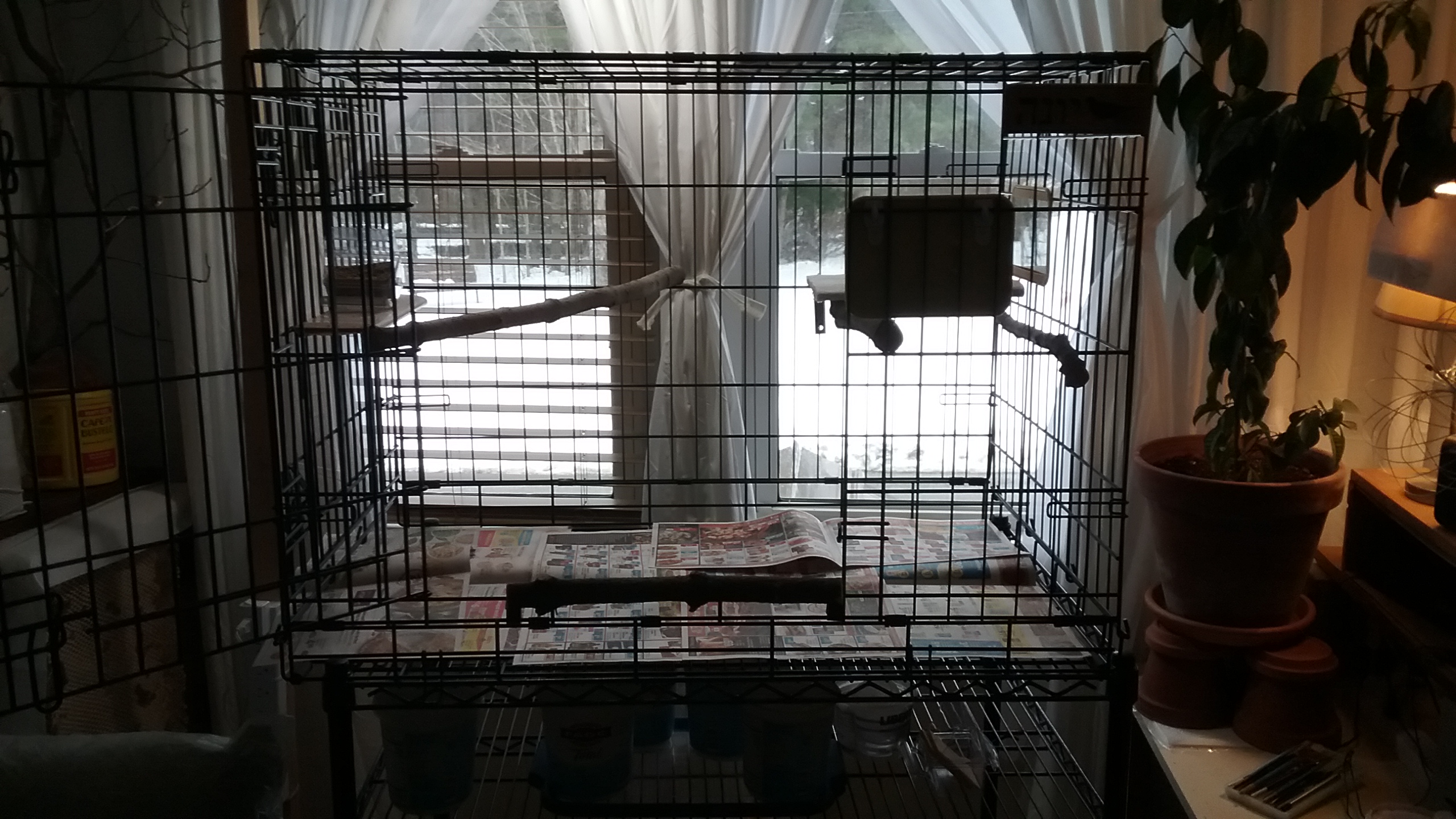
Newspaper cover whilst cleaning
|
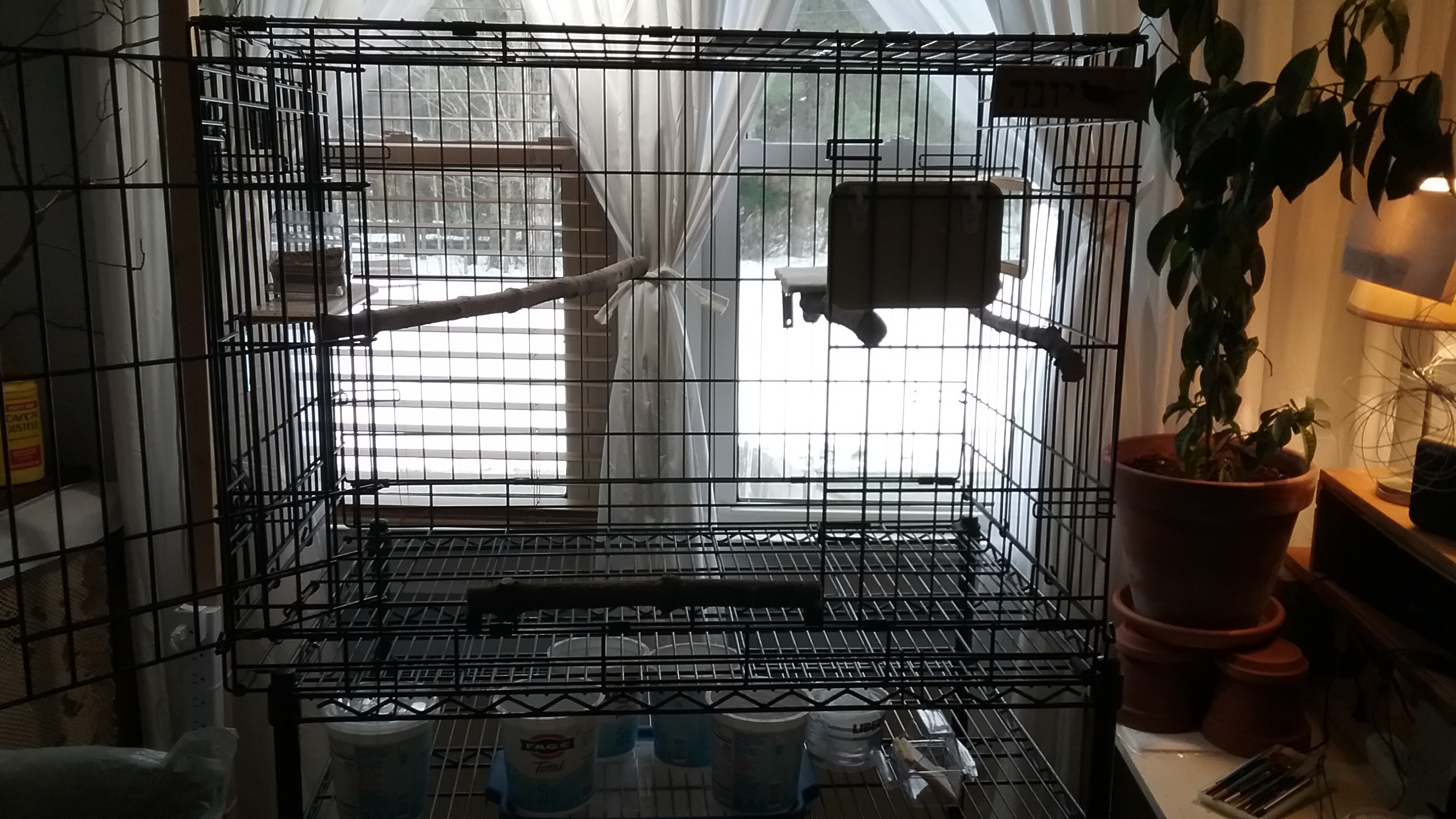
Cage completely empty
|
.jpg)
Full-size bottom tray
|
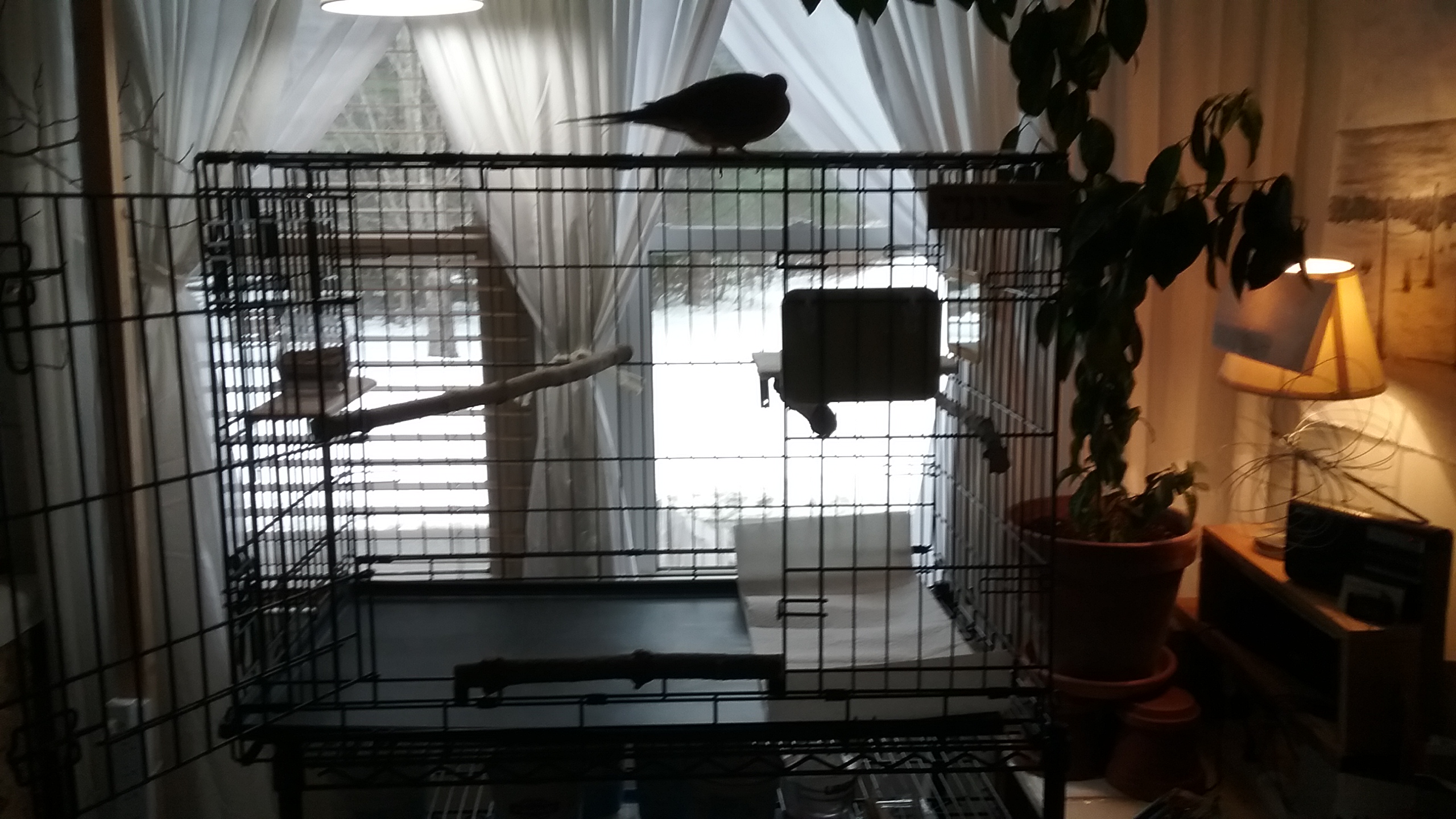
Double-layer kitchen roll
|
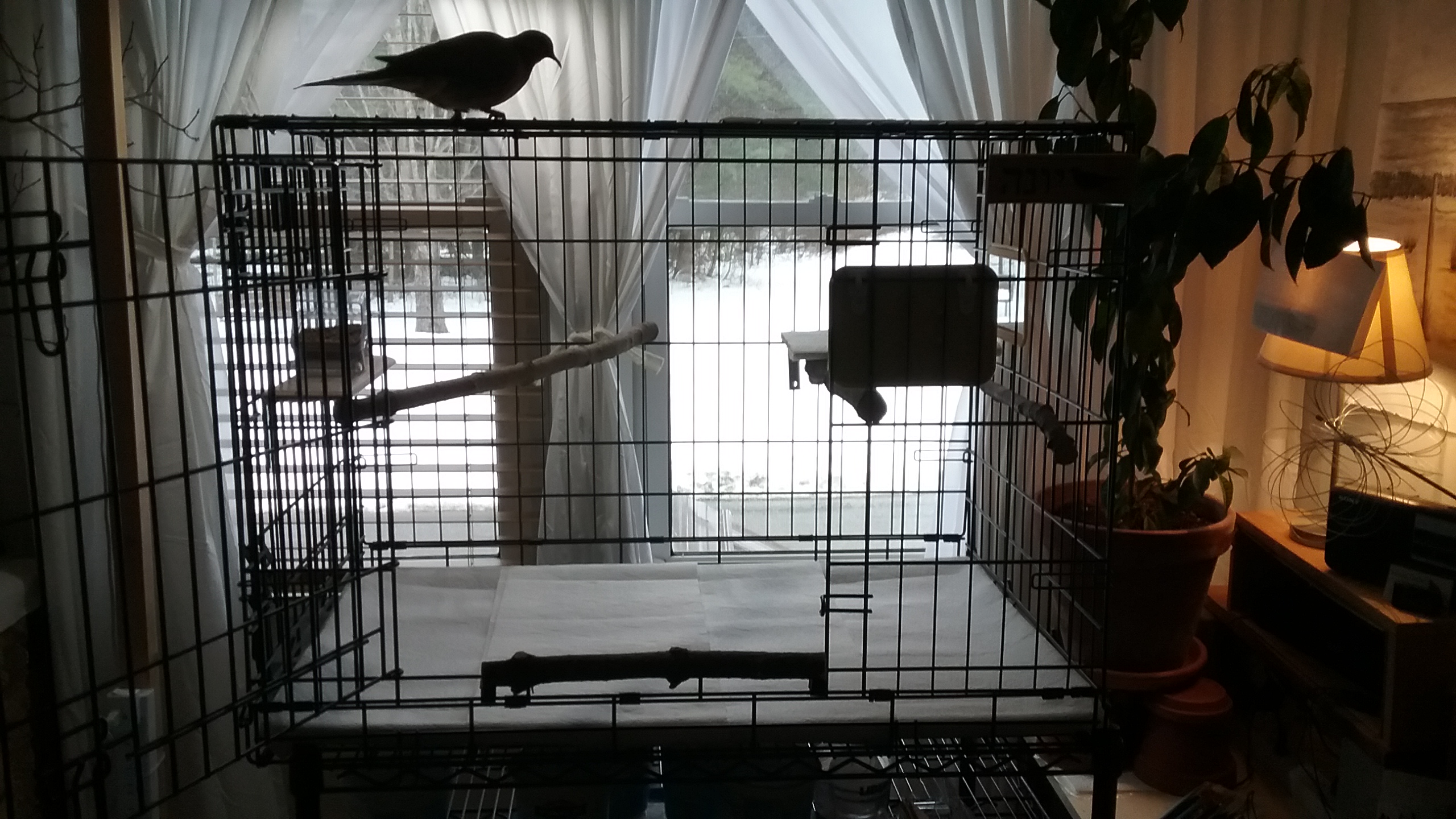
Bottom tray covered with kitchen roll
|
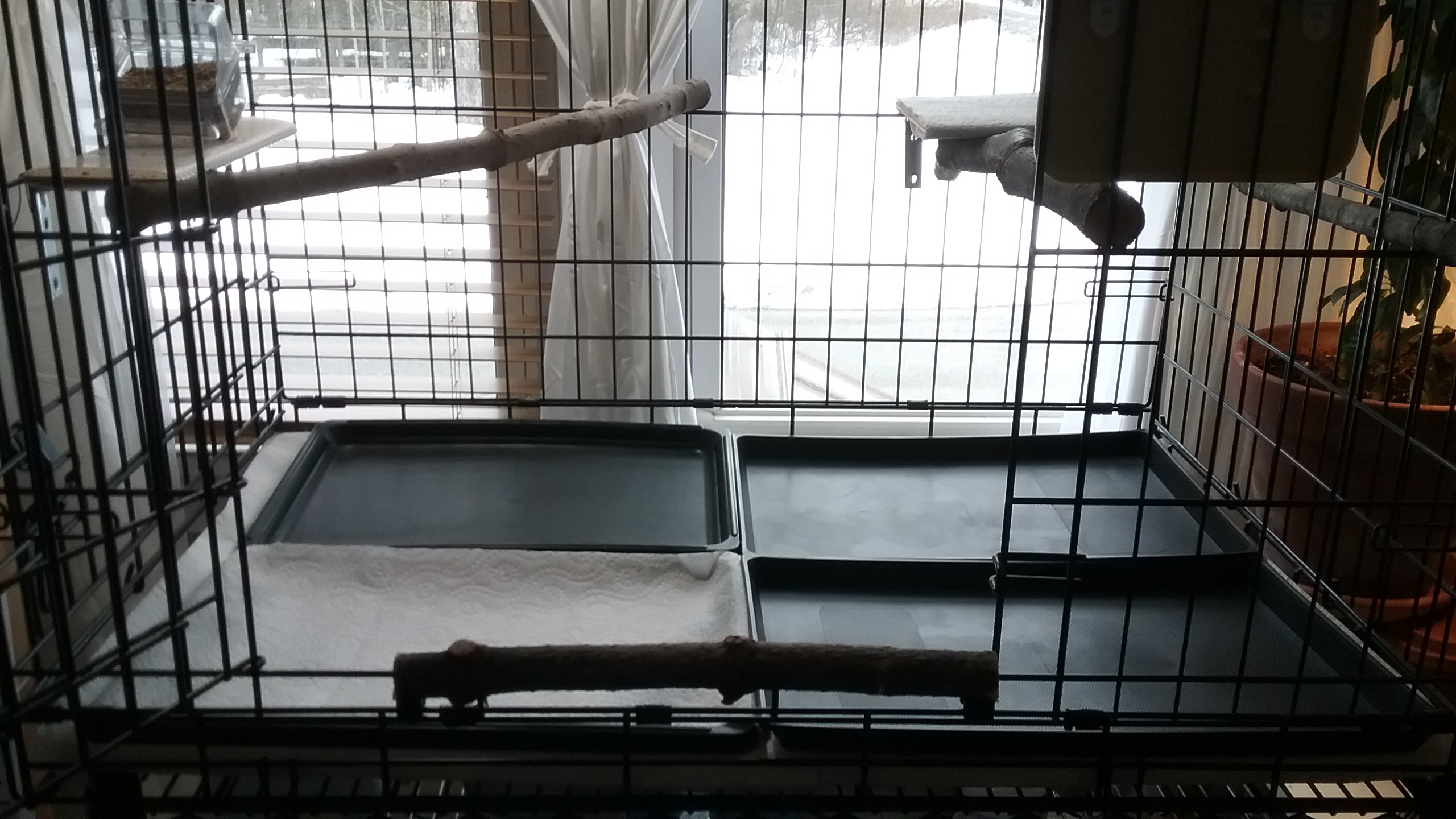
Individual trays for different areas
|
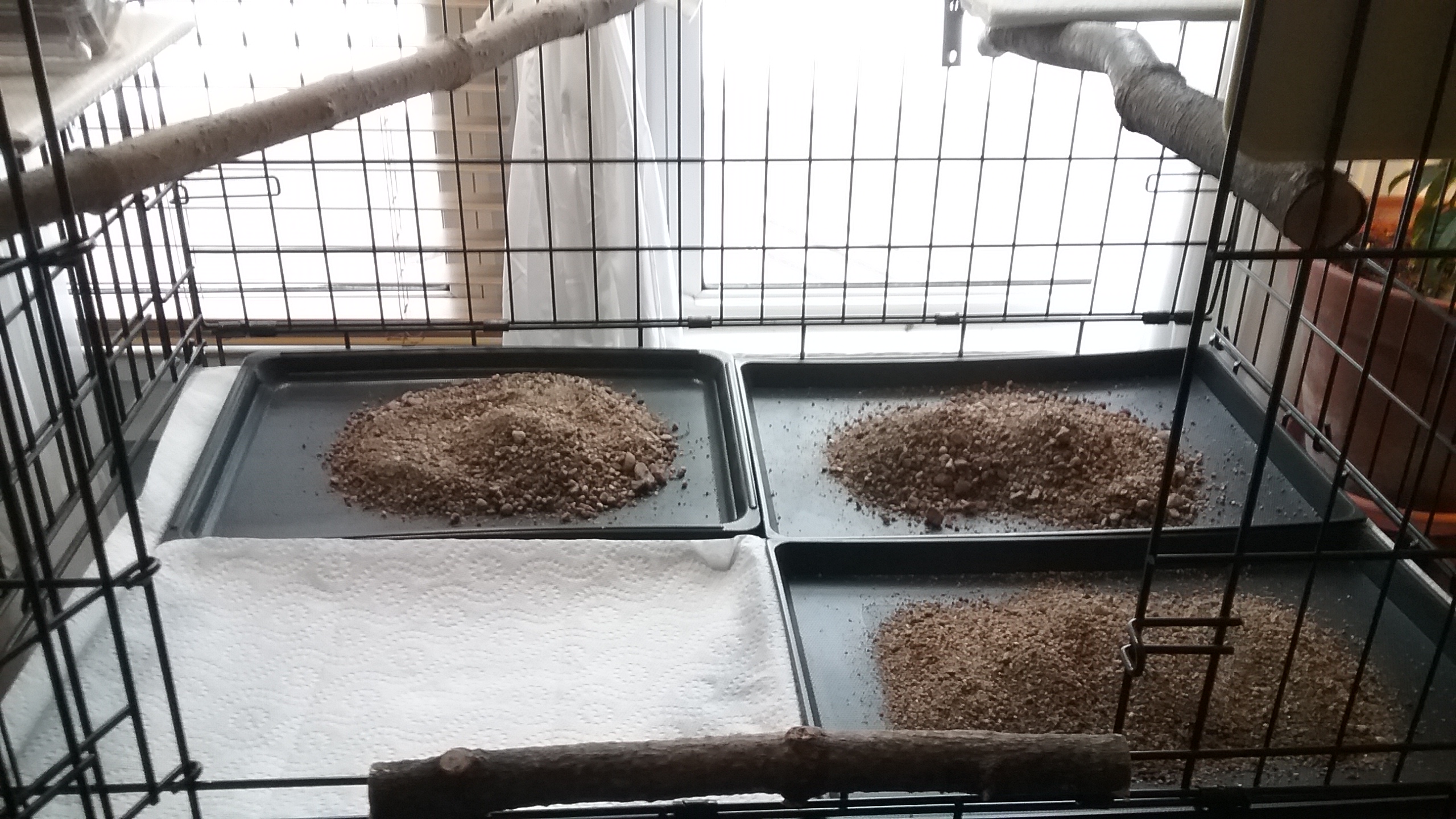
Sterile sand
|
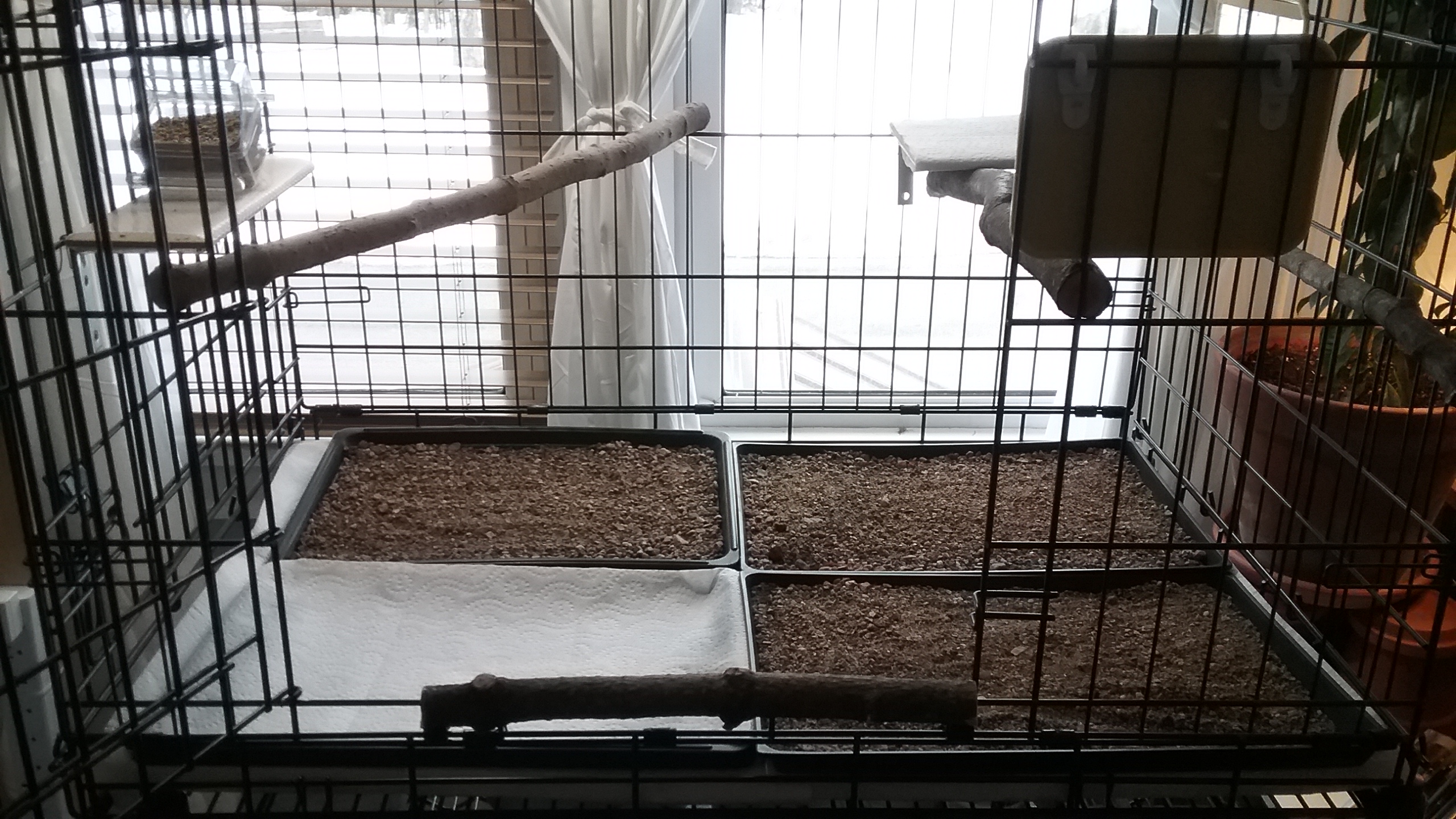
Sand for "basking" & underlayment
|
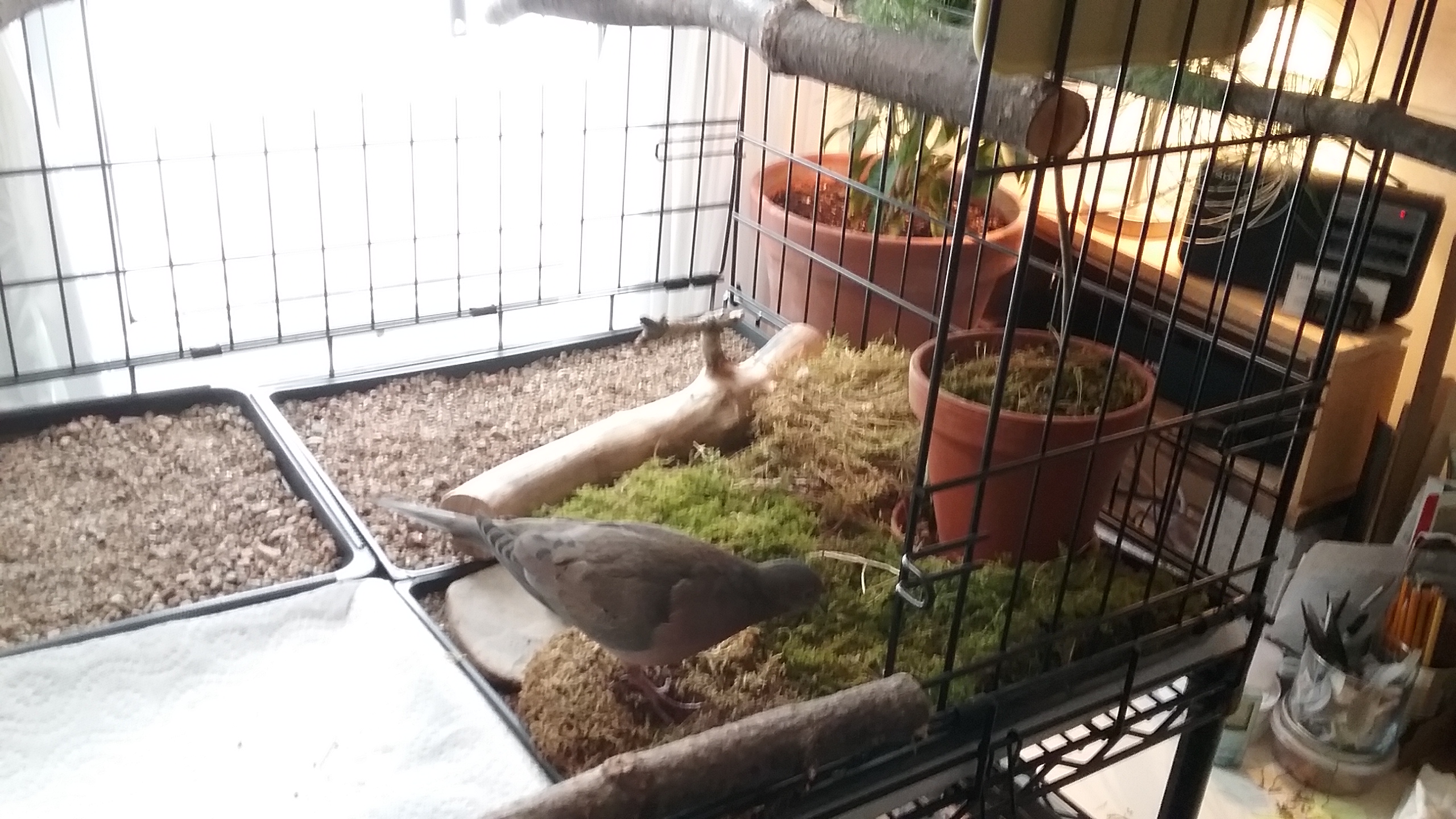
Tree, moss, &c.
|
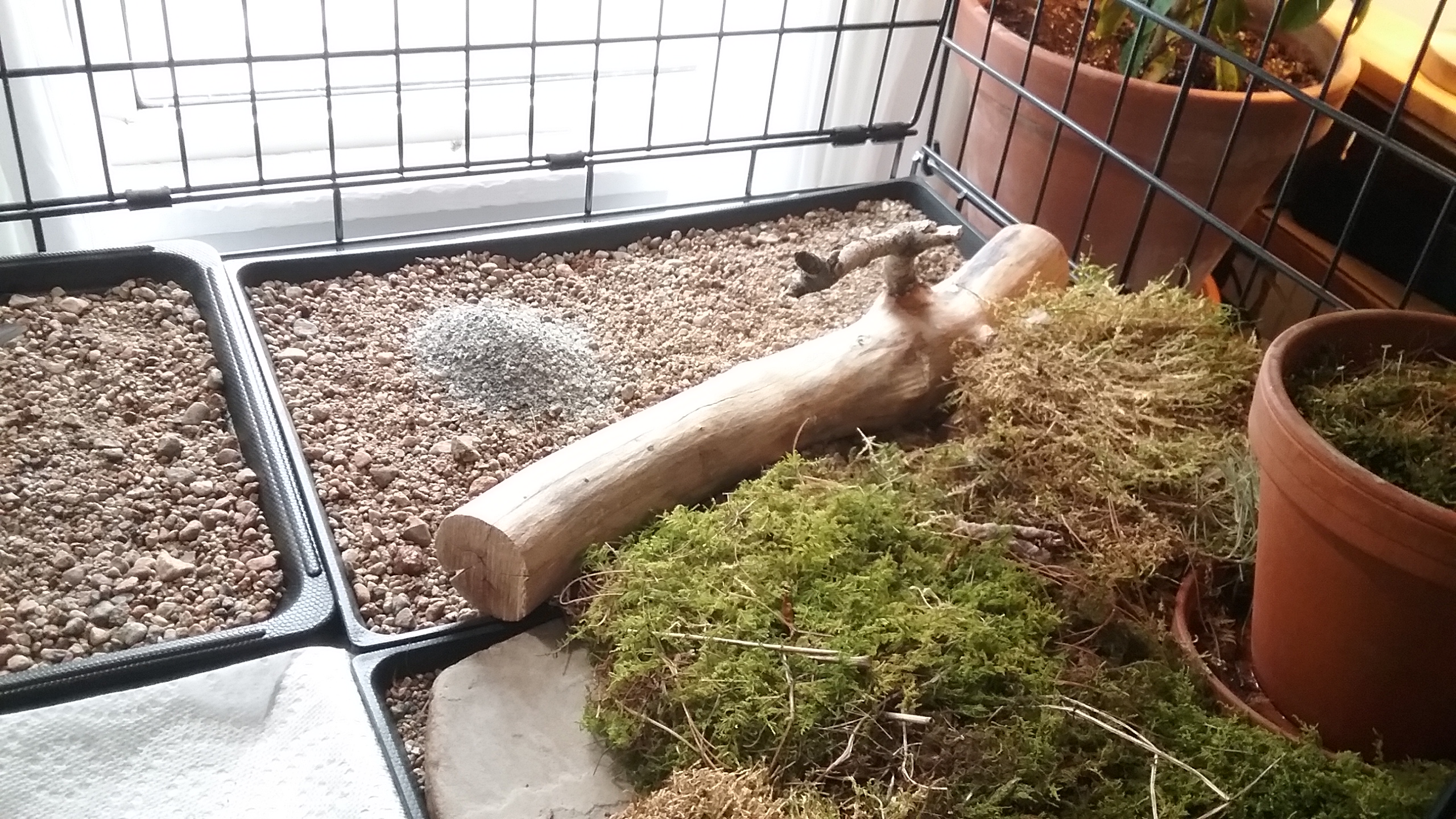
Bird grit added to sand (provides calcium)
|
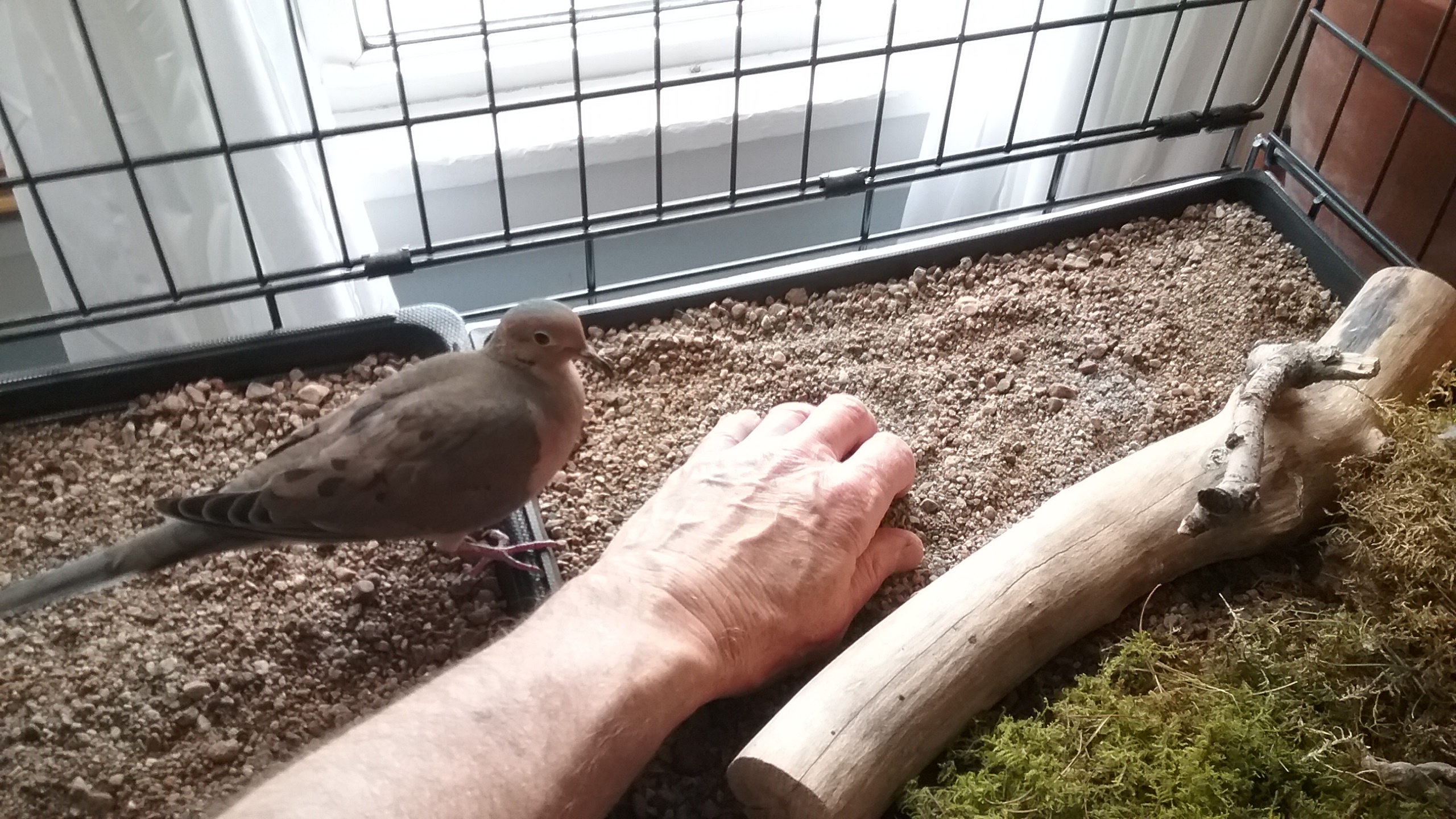
Mixing grit with sand
|
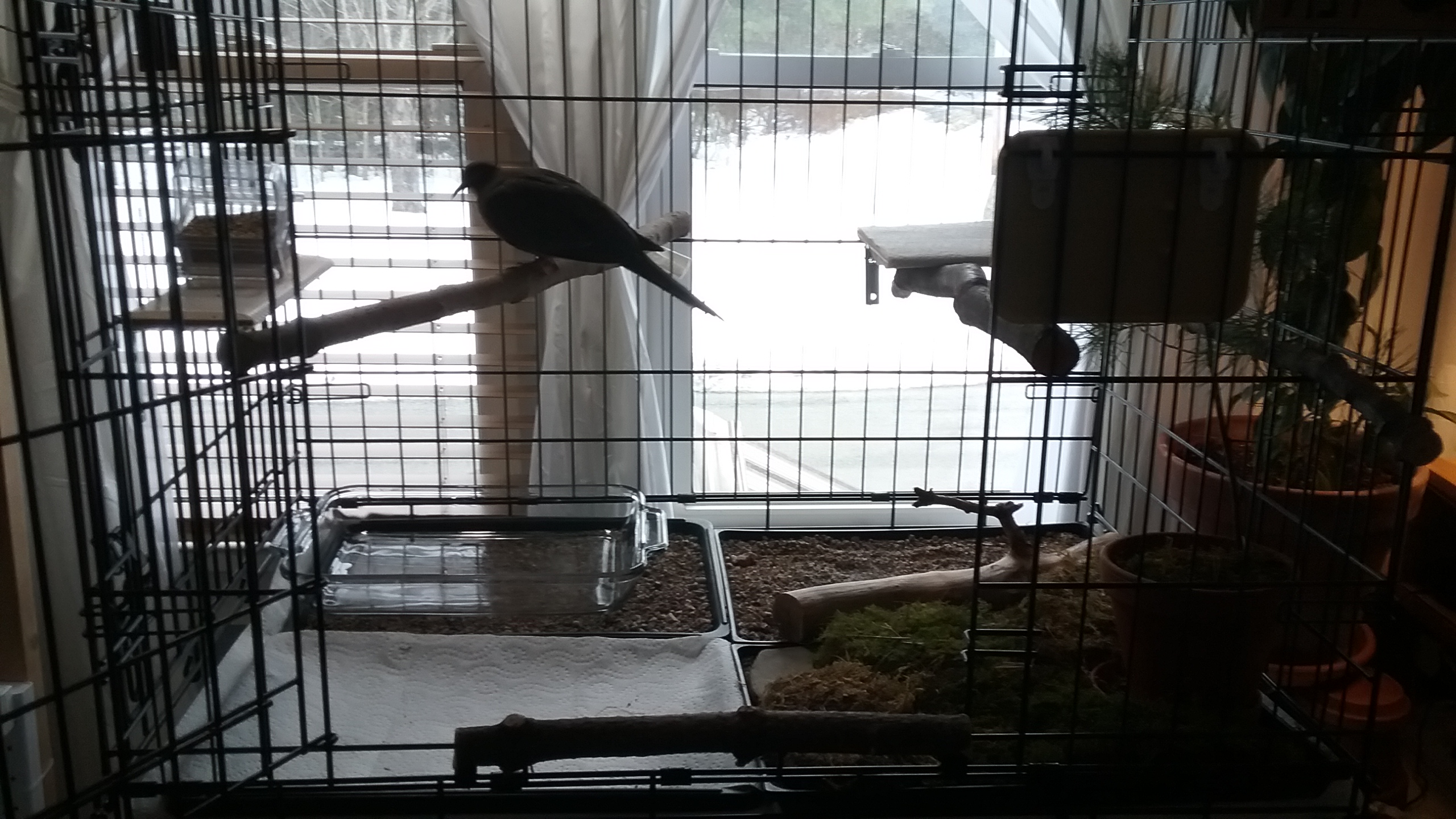
"Pool" installed
|
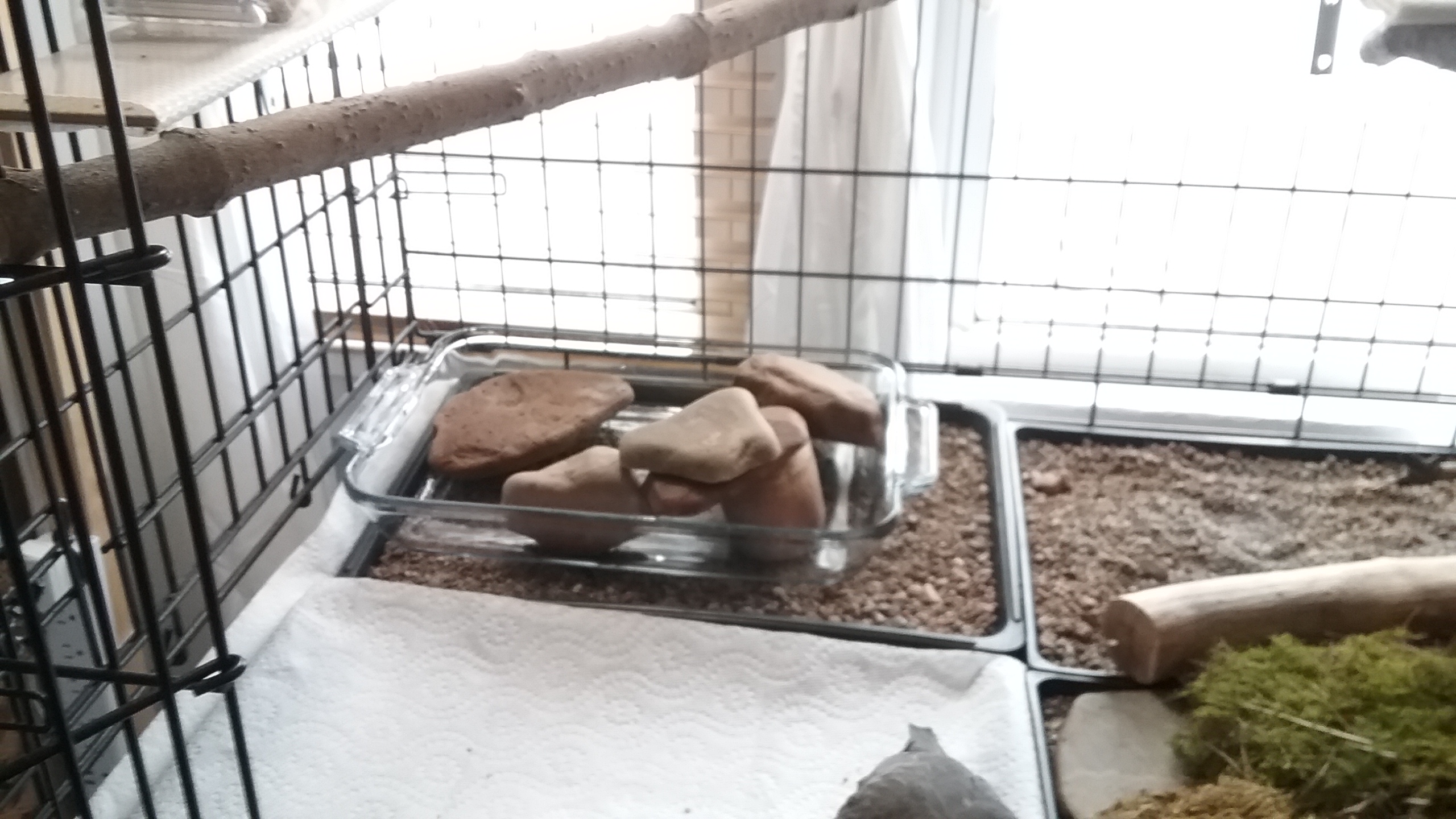
Rocks for fountain
|
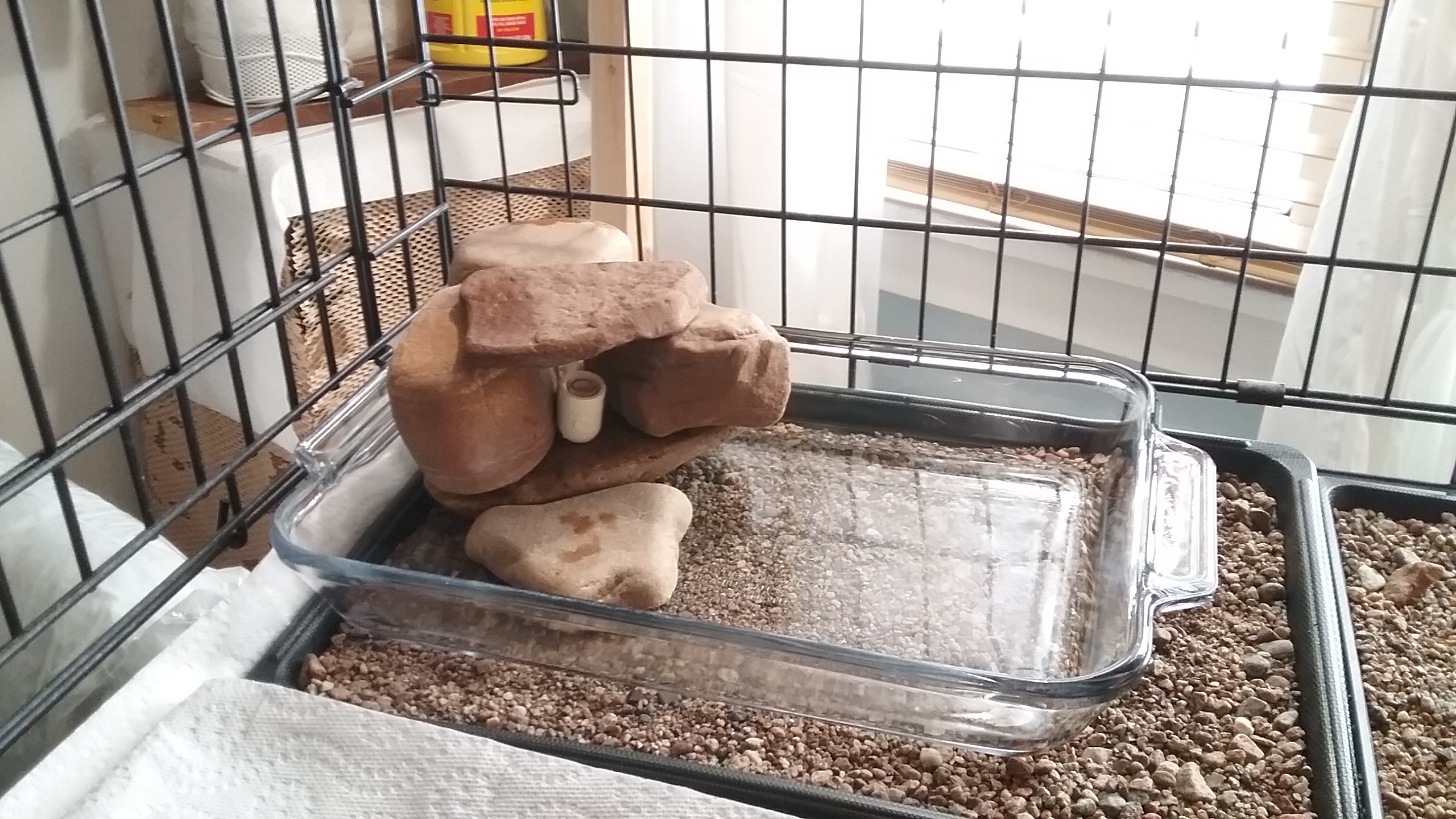
Fountain configuration
|
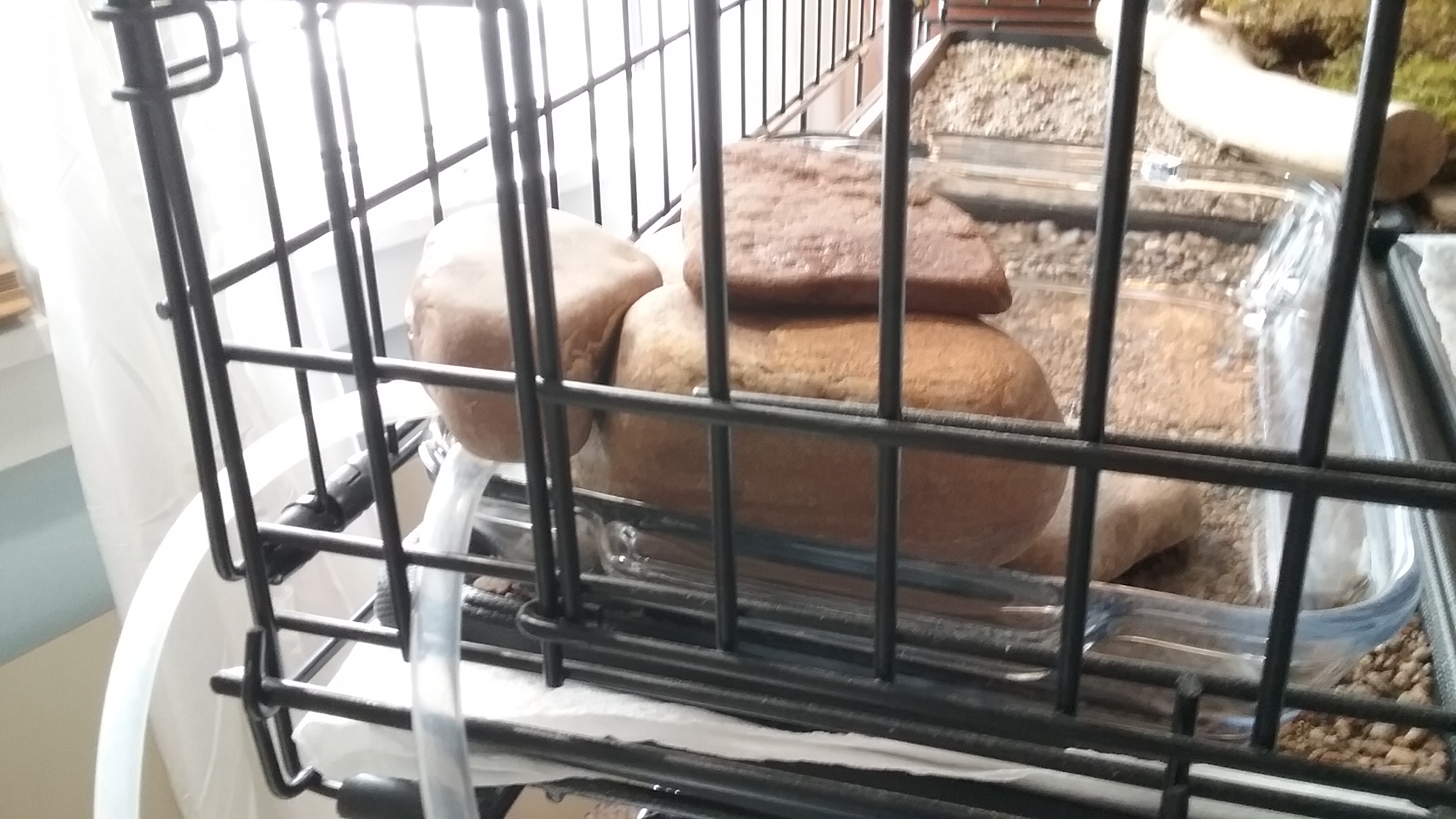
Fountain tubing configuration
|
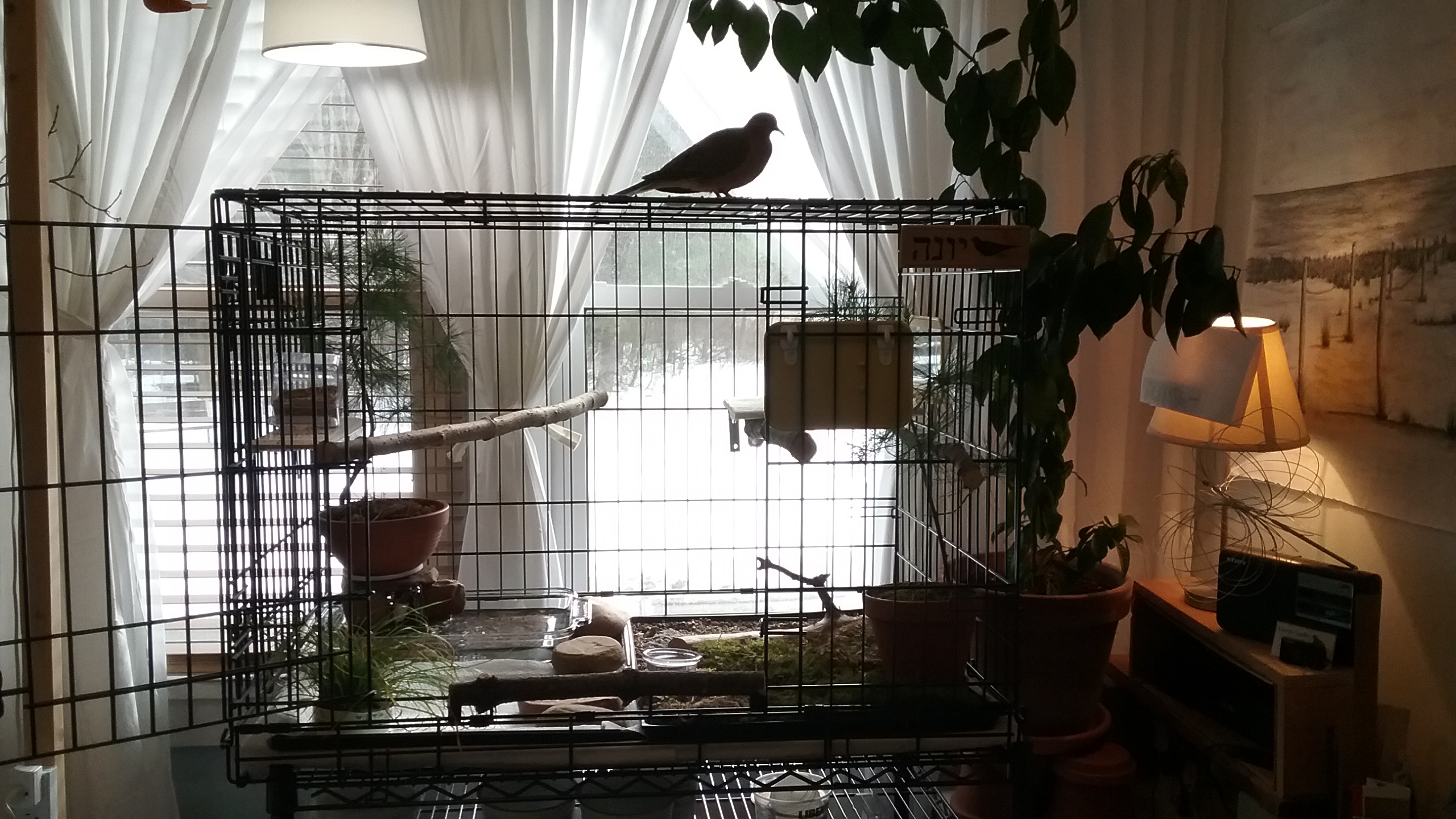
Completed, Inspected, Approved!
|
 COVERING THE CAGE COVERING THE CAGE 
 It's NOT recommended that you completely cover the cage, even at night! If there's a lot of light in the room where the cage is located, covering the back and/or a side that receives the most light, and top can be easily done with a heavy-weight, clean fabric, or cardboard cut to proper size. It's NOT recommended that you completely cover the cage, even at night! If there's a lot of light in the room where the cage is located, covering the back and/or a side that receives the most light, and top can be easily done with a heavy-weight, clean fabric, or cardboard cut to proper size.
*** TAKE EXCEPTIONAL CARE WHEN COVERING AND REMOVING THE COVER!
BIRDS RESPOND TO MOTION AND A LARGE OBJECT MOVING OVER-HEAD CAN BE SEEN AS A PREDATORY BIRD AND WILL CAUSE HORRIFIC PANIC!
AS YOU PLACE AND REMOVE ANY COVER, TALK, QUIETLY, REASSURINGLY. COMPLETE SILENCE AS SOMETHING MOVES ABOUT THE CAGE AND SUDDENLY BLOCKS LIGHT WILL CAUSE TRAUMA! ***
Experience here: Talk, softly, assuringly as you place or remove ANY covering. Eventually, it'll become "familiar", that, at certain times of the day, the cover will be put on and taken off. Still, best to speak at these times. DOVES ARE COGNIZANT! They DO notice actions, activities, motion, sounds AND your voice and tone.
OK. Night time comes, the house is lit, but it's late evening... or night. Domestic birds are often covered for the night. What about a mourning dove? No. "Covering" the cage completely can cause stress, especially when followed by darkness and silence. Also, wild birds perceive a large, dark presence above them as PREDATORS! A piece of fabric can "appear" to be a large hawk, an eagle, or a pouncing cat! AND, they're aware of even the slightest motion in the air. Their feathers are extremely sensitive and receptive of air currents. *** KEEP IN MIND: ONE OF THE HIGHEST CAUSES OF DEATH FOR BIRDS IS * HEART ATTACK *. *** ADD TO THIS, DOVES CAN'T SEE WELL IN THE DARK. BY SUN-SET, THEY'RE ROOSTING, SAFELY, FOR THE NIGHT. YOU KNOW WHAT'S HAPPENING, WHAT'S "FLOATING" AROUND, A DOVE DOESN'T AND CAN'T. SO THE FLUTTER OF A BLANKET IN THE AIR CAN SEEM TO BE AN ATTACK. *** Think of it this way: All day, the world is visible, even through the cage. Light and air is abundant. Suddenly... some fabric or the likes comes down from the sky, it surrounds on top and all sides! There's NOTHING to be seen! There are sounds, noises, voices, but there's no way to SEE where it's all coming from! NOT the most comforting situation, especially for a bird... and even MORE-so for a bird that's used to being in the open through the night. And though, to you, the sounds of the house are "common" and "normal", SOME of those sounds could be interpreted as predators! Predators that can't be seen!
If you must block some light, an intrusive street light, or head-lights (if you're located on a bend in the road or an intersection where head-lights from vehicles suddenly come flashing into the room), there are various ways to block with-out fully covering the cage.
Yonah's "house" (I just don't like the sound of the word "cage"... I much prefer to think of it as his "house" with-in our larger house) is situated in the window that receives the most sun-light during the day, but there's an annoying street light just out-side the window (one of those new "LEDs" that illuminates the world like NYC Times Square). We're also situated on a bend in the road and the head-lights of on-coming vehicles flood, momentarily, in through the window at night. It's all annoying to me, but more-so to a being who's been accustomed to darkness through a night.
I purchased "room darkening blinds" (not shades nor curtains... "Venetian blinds") which block mch of the intrusive light from out-side and yet, in warm weather, will allow for breezes and general air circulation. At or just before sun-set, the blinds are drawn and closed, curtains are drawn closed. About an hour later, the "back board" is attached to the window-side of his house. Just before he's ready to roost for the night, the "roof board" is set a-top. THIS COVERS ONLY ABOUT 75% OF HIS ROOF AND IS ADDED TO BLOCK ANY OVER-HEAD LIGHT FROM THE OUT-SIDE. THREE SIDES, INCLUDING THE FRONT ARE LEFT UN-COVERED. The boards are ply-wood "underlayment", thin, light-weight, non-toxic. As a substitute for boards, a solid color (preferably earth-tone in colour) may be used. Cover the "lighted" side first, then draw the rest over as need before sleep time, leaving three sides open and about 25% of the roof as well.
.jpg) ^ Click Image For Larger Size ^
^ Click Image For Larger Size ^
You can make a simple, easy "block" for what-ever side of the cage faces the window with a piece of card-board that covers the length and height of the cage and, you can make it so that it hooks to the top of the cage. Another piece on the top (if the cage has a flat top) is perfectly fine. As you put these up for the night, and in the morning as you remove them, TALK, quietly, softly, in a "comforting" tone so that the dove will come to associate all the activity with you and your caring. Once the "covers" are in place, take a moment to continue the re-assurance that everything is fine. At first, you'll notice a bit of trepidation, a bit of "pacing", a constant turning of the head, looking up, down, around. Hey, the lighting has dimmed considerably, it's gotten dark rather suddenly, and the "world" is gone. Just as "windows" don't make sense to a wild life, blocking the light of day artificially doesn't make sense either. But hearing a familiar, calm voice brings a sense of protection and security and calmness. Again, in the morning it's the same situation, only in reverse... opening the curtains removing the block, there's suddenly day-light. So again, a voice of assurance is appreciated... and necessary...TALK, quietly, softly, in a "comforting" tone
Of course, if you can just get away with no covering at all, that's perfect.
*Note: Doves normally need 10-14 hours of rest/sleep. So set your clock accordingly.
For Reference, our regular schedule for covering and un-covering runs:
• In the evening... about an hour before sun-set, the waters in the pool and drinking dish are COMPLETELY changed.
• At this time, any "poops" are removed, checked and discarded.
• The "Natural Spectrum" light is put on.
• At sun-set, window blinds and curtains are closed. The "Natural Spectrum" (you can use a "Full Spectrum" light if you choose) light is still on to encourage a "light snack" before sleep. Doves will eat before sleeping and digest through the night.
• An hour later, the back board is put in place, a small desk lamp with a "soft" glow (incandescent) is turned on and the "Natrual Spectrum" light is turned off. This mimics "evening".
• At this time, music (Yonah has a collection of bird-songs that play during the day, and often, the radio will be on, at low volume for added sounds) is turned off.
• This gives about 30 minutes of peace, quiet, "the flocks" have gone to roost for the night. It's a nice time to pull-up a chair and have a quiet "chat" about the day.
• 30 minutes later, the roof board is placed, a little re-assuring "chat" in low voice is made to assure that all is safe.
• Since Yonah isn't "confined" to his house during the day, when he's settled on his "night-roost", I close the door to his house. This is essentially, in case something startles him during the night and prevents him from flying out and about in a dark room where, since his sight is quite limited, he could collide with furnishings or walls.
• All lights are turned off.
• Yonah has his own room, so the door is half-closed for another 30 minutes to an hour to give just enough light from the rest of the house so that he can "situate" himself for the night.
• At that point, I close the door, leaving it open about 2-fingers width for circulation and so that I can hear in case something distrubs him during the night.
• In the morning, I normally wait for Yonah to "call" to let me know that he's awake. Usually this happens shortly after dawn, but, of course, if it gets much later, I go into his room, silently at first, but then whispering so that he knows that it's me coming in and not a predator.
• NOTE: Doves "half-sleep" generally. Literally, one half of their body and mind sleeps whilst the other half remains alert for predators. If you approach in silence, especially in a darkened room, you could cause panic. So DO speak... softly, re-assuringly as you approach.
• Once it's been established that Yonah is awake, AS I TALK, the roof board is removed, the door to his house is opened.
• Next, the back board is removed (I'm still talking to him through this).
• The curtains and blinds are open to let the morning light into the room.
• When this is complete, it's time for the daily "morning routine"... first and foremost, ALL WATERS ARE COMPLETELY CHANGED, THE POOL AND DISH ARE COMMPLETELY RINSED CLEAN. (Yes, EVERY DAY.)
• Poops are removed, checked and disposed of.
• Any food left-over from the evening before is removed and replaced with fresh.
•"Bird-songs" are turned on. (Oh... Yonah has his own "MP3" player with a collection of various bird-songs, including, of course, mourning doves. I plays all day.)
• And... we get on with our day.
|

